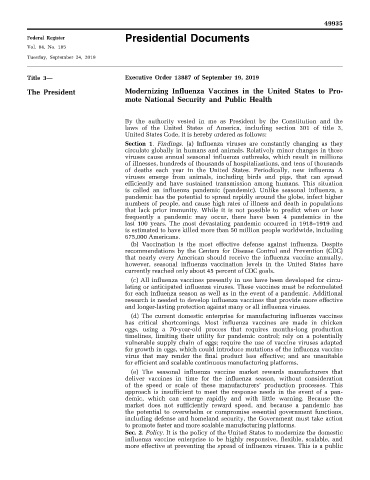Page 913 - Trump Executive Orders 2017-2021
P. 913
49935
Federal Register Presidential Documents
Vol. 84, No. 185
Tuesday, September 24, 2019
Title 3— Executive Order 13887 of September 19, 2019
The President Modernizing Influenza Vaccines in the United States to Pro-
mote National Security and Public Health
By the authority vested in me as President by the Constitution and the
laws of the United States of America, including section 301 of title 3,
United States Code, it is hereby ordered as follows:
Section 1. Findings. (a) Influenza viruses are constantly changing as they
circulate globally in humans and animals. Relatively minor changes in these
viruses cause annual seasonal influenza outbreaks, which result in millions
of illnesses, hundreds of thousands of hospitalizations, and tens of thousands
of deaths each year in the United States. Periodically, new influenza A
viruses emerge from animals, including birds and pigs, that can spread
efficiently and have sustained transmission among humans. This situation
is called an influenza pandemic (pandemic). Unlike seasonal influenza, a
pandemic has the potential to spread rapidly around the globe, infect higher
numbers of people, and cause high rates of illness and death in populations
that lack prior immunity. While it is not possible to predict when or how
frequently a pandemic may occur, there have been 4 pandemics in the
last 100 years. The most devastating pandemic occurred in 1918–1919 and
is estimated to have killed more than 50 million people worldwide, including
675,000 Americans.
(b) Vaccination is the most effective defense against influenza. Despite
recommendations by the Centers for Disease Control and Prevention (CDC)
that nearly every American should receive the influenza vaccine annually,
however, seasonal influenza vaccination levels in the United States have
currently reached only about 45 percent of CDC goals.
(c) All influenza vaccines presently in use have been developed for circu-
lating or anticipated influenza viruses. These vaccines must be reformulated
for each influenza season as well as in the event of a pandemic. Additional
research is needed to develop influenza vaccines that provide more effective
and longer-lasting protection against many or all influenza viruses.
(d) The current domestic enterprise for manufacturing influenza vaccines
has critical shortcomings. Most influenza vaccines are made in chicken
eggs, using a 70-year-old process that requires months-long production
timelines, limiting their utility for pandemic control; rely on a potentially
vulnerable supply chain of eggs; require the use of vaccine viruses adapted
for growth in eggs, which could introduce mutations of the influenza vaccine
virus that may render the final product less effective; and are unsuitable
for efficient and scalable continuous manufacturing platforms.
(e) The seasonal influenza vaccine market rewards manufacturers that
deliver vaccines in time for the influenza season, without consideration
of the speed or scale of these manufacturers’ production processes. This
approach is insufficient to meet the response needs in the event of a pan-
demic, which can emerge rapidly and with little warning. Because the
khammond on DSKJM1Z7X2PROD with PRESDOC VerDate Sep<11>2014 15:36 Sep 23, 2019 Jkt 247001 PO 00000 Frm 00001 Fmt 4705 Sfmt 4790 E:\FR\FM\24SEE0.SGM 24SEE0
market does not sufficiently reward speed, and because a pandemic has
the potential to overwhelm or compromise essential government functions,
including defense and homeland security, the Government must take action
to promote faster and more scalable manufacturing platforms.
Sec. 2. Policy. It is the policy of the United States to modernize the domestic
influenza vaccine enterprise to be highly responsive, flexible, scalable, and
more effective at preventing the spread of influenza viruses. This is a public

